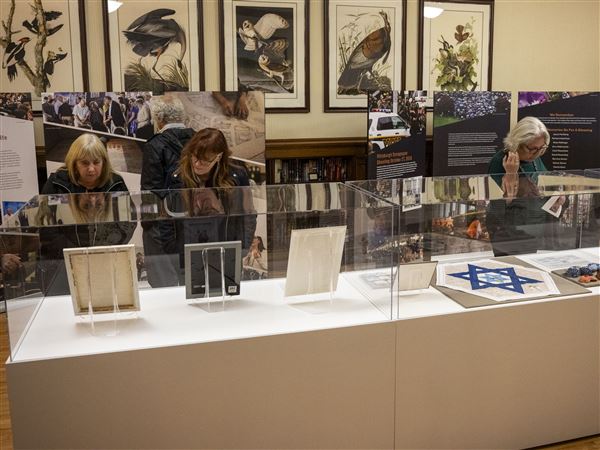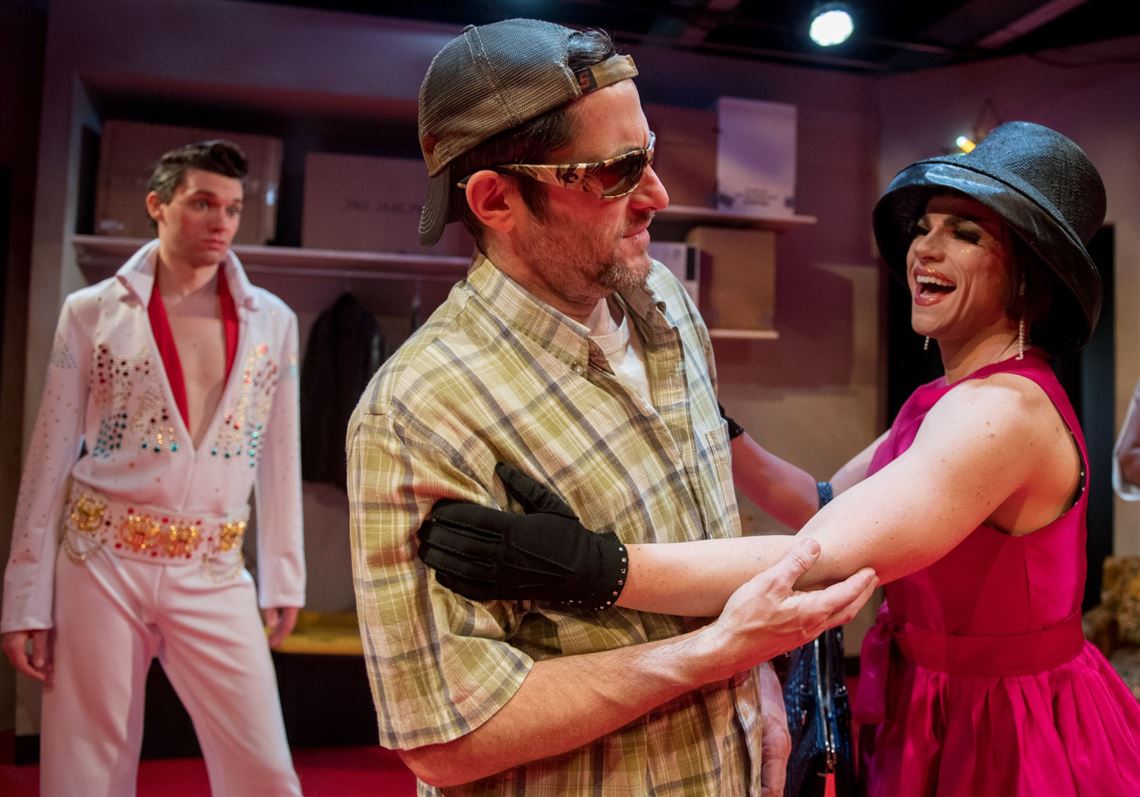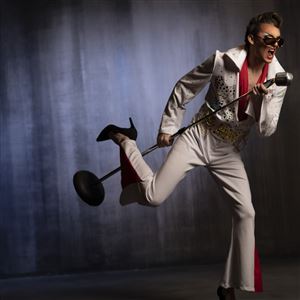Identity crises and diversity ruled the weekend in three plays making their Pittsburgh debuts. Click here for information on tickets, dates and times.
‘An Octoroon’
by Branden Jacob-Jenkins, directed by Andrew Paul for Kinetic Theatre.
In its in-your-face racism, “An Octoroon” follows the lead of films such as “Get Out” and theater works such as “The Scottsboro Boys,” a minstrel show about the Jim Crow South, and “Spring Awakening,” with words from a 19th-century taboo text. It’s a satire that turns a mirror on society. Many of us will not like what we see.
At a time when we are inundated with stories of white politicians who once wore blackface, the sight of a black man in whiteface and others in shoe-polish black or redface can be as disturbing as the news of the day. And if that’s not enough to freak you out, there’s the n-word and f-word that drop early and often, like bombs in a war zone.
Leading the Kinetic Theatre cast of “An Octoroon” is Ananias J. Dixon (“Sweat” at Pittsburgh Playwrights), who arrives onstage stripped to his underwear. He appears to want to have a conversation and tells us how his therapist has encouraged him to adapt “The Octoroon,” the 1859 play by Irishman Dion Boucicault — canny veteran actor Martin Giles, a master of deadpan comedy used to great affect here.
The playwrights (Boucicault gets a capital “P” in the program) then face off in a flurry of obscenities before the play at hand takes shape. We are told that white actors are hard to find for the roles of slave owners, so before our eyes, Mr. Dixon paints on a clownish whiteface, while Mr. Giles uses red — to portray an Indian and a sunburned slave trader.
Mr. Dixon underscores his broadly drawn characters with an empathetic, emotional performance that defies their black-and-white origins. He is a force in physically and emotionally demanding dual roles.
Parag S. Gohel then gets into heavy blackface to play, among other parts, a white-haired house slave who denigrates other people of color.
Sarah Hollis, a newcomer to Pittsburgh, plays Zoe, the “octoroon” (one eighth African-American) of the title, who is loved by new plantation owner George (Mr. Dixon) and coveted by the dastardly M’Closky (also Mr. Dixon), who plots to steal both her and the land.
Kelsey Robinson and Melessie Clark as observant and gossipy Dido and Minnie make a fine comic duo as slaves of the “Mammy” variety — a mix of humor and nervous laughter abound — and Jenny Malarkey plays the oh-so-blonde heiress Dora, who hopes to win George’s heart.
John Reilly and Dominique Brock fill out the game cast of actors who must say things that would make even the most profane rapper blush.
And did I mention the giant rabbit that inhabits this world?
The scenic design by Johnmichael Bohach includes a large screen with cue cards as in a silent movie (watch for “The Sensation”). Each time the white-on-black words came on screen Saturday, I was taken back to the horrific depictions of black men and the glorification of the Klan in “Birth of a Nation,” that racist “masterpiece” of early American cinema.
“An Octoroon,” directed by Mr. Paul with a purposefully heavy hand, resurrects the past as a horror story with humor, ripe for our time or any time.
“Savior Samuel”
by Mark Clayton Southers, directed by Monteze Freeland, dramaturgy by Kyle Bostian.
From the pre-Civil War South of “An Octoroon” to the post-Civil War northwest …
It has taken 16 years for “Savior Samuel” to reach the stage in a full production, and it’s still a work in progress. Mr. Southers, founder and artistic director of Pittsburgh Playwrights Theatre, put the play on a shelf all those years ago but dusted it off to show to Mr. Freeland, who thought it deserved a spotlight in the company’s 15th season. It is also the second of Mr. Southers 19th-century set plays to be produced by his company, after the distinguished “Miss Julie, Clarissa and John.”
It seems obvious that “Savior Samuel” was created as three acts but is now streamlined, with a few bumps here and there, to two. The Samuel of the title is born to a deaf girl named Essie, with the father a mystery. She is left distraught when he is taken by her parents and supposedly sent to an Indian orphanage — although the baby is black, they suspect the father might be Native American, or perhaps Essie’s father.
The baby is given to Rory, a preacher and doctor whose wife has been left lame after a terrible beating. They name the child until they realize he is blind. Samuel — unseen throughout — is finally sent to the orphanage, while everyone who has been in his presence experiences profound changes.
Jonathan Berry’s Rory, a winning combo of confidence and insecurities, is a tie that binds the places Samuel calls home. Rory visits Essie’s family, with Wali Jamal and Cheryl El-Walker as her parents and newcomer Aaliyah Sanders as the young mother, forming a believable unit living in wilds where the threat of a human or animal attack is ever-present.
Sam Lothard is the jovial Dukem, Rory’s friend with a secret past, and Susie McGregor-Laine and Marsha Mahak as Mother Superior and Sister Bethany are a study in the old and new guard of a Catholic-run orphanage.
With a movable wood backdrop created by Diane Melchitzky, Pittsburgh Playwrights makes the most of the rectangular space on the fourth-floor of the Trust Arts Education Center, the company’s temporary venue while their home down the street on Liberty Avenue is undergoing renovations. Errant noises including the heating system were a distraction at Sunday’s performance, which revealed a new play with the potential to fill a void of despair with uplift and hope.
“The Legend of Georgia McBride”
by Matthew Lopez, directed by Patrick Jordan.
There are so many things to celebrate about this barebones production, but what stayed with me through the weekend was the blue-eyed, deer-in-the-headlights stare of Andrew Swackhamer.
As Casey, a good-natured former high school footballer and failed Elvis impersonator, he is thrust into the spotlight of a drag queen show with mere minutes of preparation. In his eyes (and many costume changes), we see the transition from terror to Georgia McBride, the toast of Panama City’s drag scene.
The energy level hits on all cylinders when Shua Potter arrives onstage, with a commanding presence that comes from his day job as a drag queen and Liza Minnelli impersonator. As Miss Tracy Mills, the Pittsburgh native is a fount of wit and wisdom and a sparkling entertainer.
While Tracy knows where she stands as a performer and in life, other characters undergo life-altering transformations: David Conrad as a gruff bar owner who just wants to make money; Sara WIlliams as Casey’s practical, pregnant wife; and Justin Lonesome in two roles, notably as an aloof diva with a drinking problem. Mr. Lonesome gives one of his most passionate performances as he schools Casey about the lifestyle he is about to embrace.
For Casey, the route from Elvis to Georgia McBride means learning to move those long legs in sky-high heels, as well as wrestling with long-held precepts about what it means to be a man. The only thing missing in Casey’s morph to Georgia is eye makeup — I can only imagine what a little mascara could do for those big baby blues.
The lip-sync drag shows are uproarious fun. With just a few weeks prep time, Mr. Jordan has pulled together a cast and creative team of pros for a show that demonstrates the power that can emanate from that tiny Braddock stage. With music and makeup and wigs — oh, those wigs! — “Georgia McBride” is a glitz-wrapped portrait of a loving couple’s capacity for change and acceptance, and the larger-than-life people who help them along the way.
Sharon Eberson: seberson@post-gazette.com or 412-263-1960. Twitter: @SEberson_pg. Sign up for the PG performing arts newsletter Behind the Curtain at Newsletter Preferences.
First Published: February 19, 2019, 3:31 p.m.


















